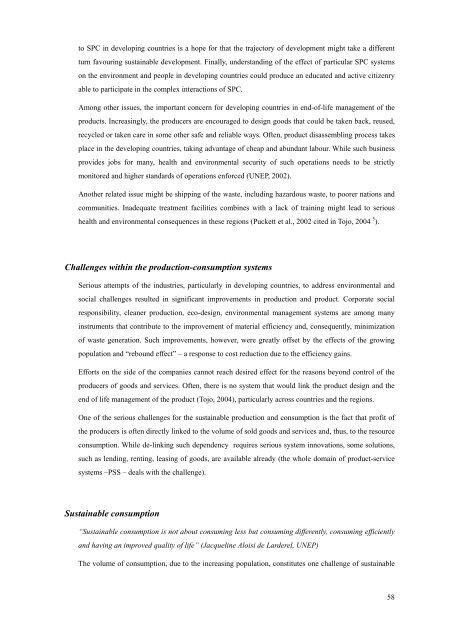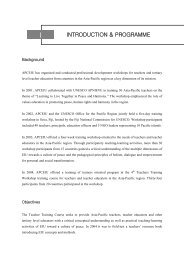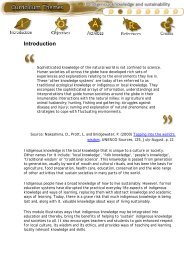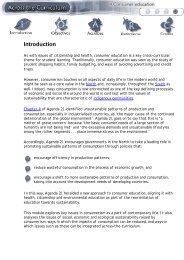REPORT OF UNESCO EXPERT MEETING ON - APCEIU
REPORT OF UNESCO EXPERT MEETING ON - APCEIU
REPORT OF UNESCO EXPERT MEETING ON - APCEIU
You also want an ePaper? Increase the reach of your titles
YUMPU automatically turns print PDFs into web optimized ePapers that Google loves.
to SPC in developing countries is a hope for that the trajectory of development might take a different<br />
turn favouring sustainable development. Finally, understanding of the effect of particular SPC systems<br />
on the environment and people in developing countries could produce an educated and active citizenry<br />
able to participate in the complex interactions of SPC.<br />
Among other issues, the important concern for developing countries in end-of-life management of the<br />
products. Increasingly, the producers are encouraged to design goods that could be taken back, reused,<br />
recycled or taken care in some other safe and reliable ways. Often, product disassembling process takes<br />
place in the developing countries, taking advantage of cheap and abundant labour. While such business<br />
provides jobs for many, health and environmental security of such operations needs to be strictly<br />
monitored and higher standards of operations enforced (UNEP, 2002).<br />
Another related issue might be shipping of the waste, including hazardous waste, to poorer nations and<br />
communities. Inadequate treatment facilities combines with a lack of training might lead to serious<br />
health and environmental consequences in these regions (Puckett et al., 2002 cited in Tojo, 2004 5 ).<br />
Challenges within the production-consumption systems<br />
Serious attempts of the industries, particularly in developing countries, to address environmental and<br />
social challenges resulted in significant improvements in production and product. Corporate social<br />
responsibility, cleaner production, eco-design, environmental management systems are among many<br />
instruments that contribute to the improvement of material efficiency and, consequently, minimization<br />
of waste generation. Such improvements, however, were greatly offset by the effects of the growing<br />
population and “rebound effect” – a response to cost reduction due to the efficiency gains.<br />
Efforts on the side of the companies cannot reach desired effect for the reasons beyond control of the<br />
producers of goods and services. Often, there is no system that would link the product design and the<br />
end of life management of the product (Tojo, 2004), particularly across countries and the regions.<br />
One of the serious challenges for the sustainable production and consumption is the fact that profit of<br />
the producers is often directly linked to the volume of sold goods and services and, thus, to the resource<br />
consumption. While de-linking such dependency requires serious system innovations, some solutions,<br />
such as lending, renting, leasing of goods, are available already (the whole domain of product-service<br />
systems –PSS – deals with the challenge).<br />
Sustainable consumption<br />
“Sustainable consumption is not about consuming less but consuming differently, consuming efficiently<br />
and having an improved quality of life” (Jacqueline Aloisi de Larderel, UNEP)<br />
The volume of consumption, due to the increasing population, constitutes one challenge of sustainable<br />
58








